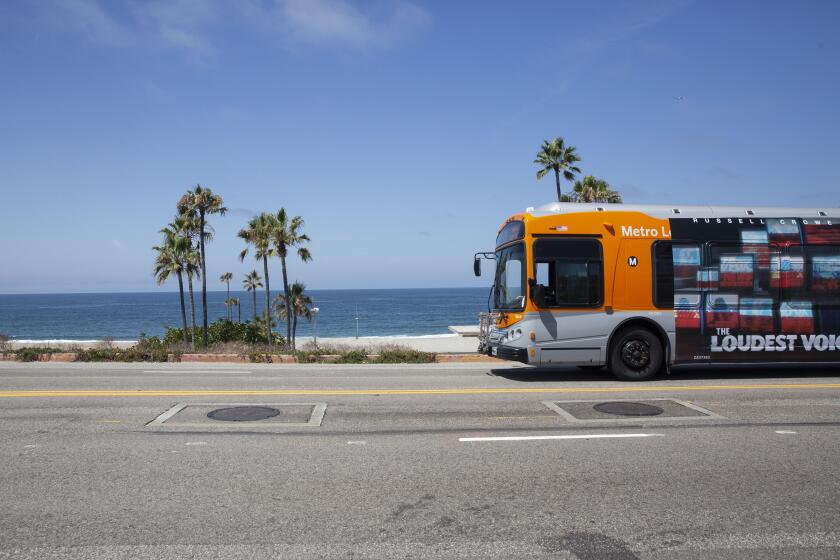Living in L.A., one Airbnb at a time
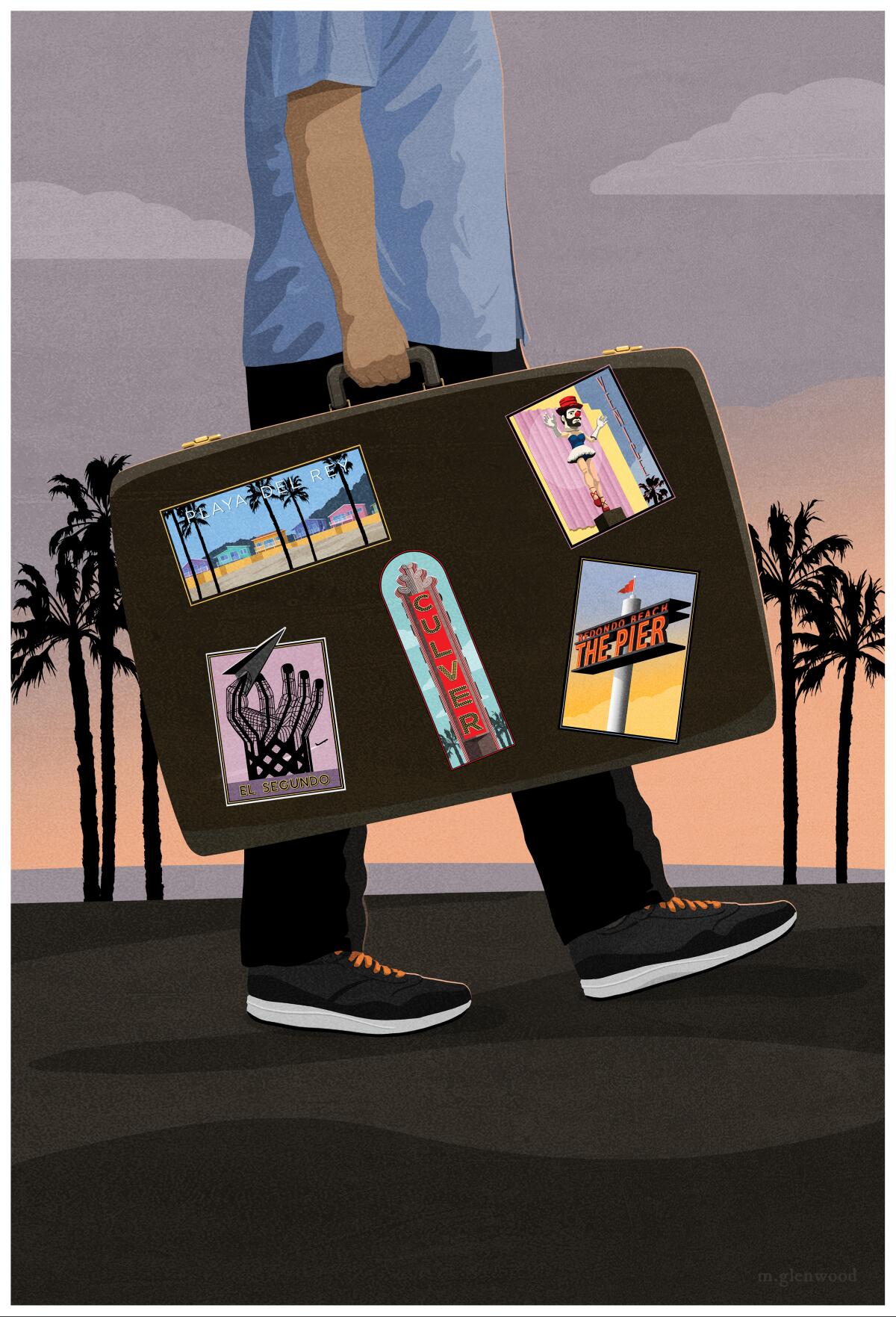
- Share via
It is a beautiful Southern California afternoon in early June, and I am standing on the deck of the Airbnb I have rented in the tiny beach town of Playa del Rey, looking out at the sliver of an ocean view and anticipating my first cocktail of the day as sunset approaches. This is now the sixth Airbnb I have lived in since moving from New York to Los Angeles in late January — some for as long as four weeks; one as short as three days — as I have spent the past five months testing out different neighborhoods in the L.A. area.
It seemed a reasonable way to check out my possible future home. I figured that I would learn more about each prospective neighborhood by living there for a couple of weeks than by dashing in and out with a real estate agent over the course of an hour or two. And while there were some hiccups along the way (including one very surprising and unwelcome visitor) and I did begin to weary of the never-ending unpacking and packing and the constant need to quickly familiarize myself with the workings of a new house, it did prove a remarkably efficient way to research living in the L.A. area. In all, I stayed in nine rentals in seven communities: Westchester, Manhattan Beach (twice), Redondo Beach, Culver City, Playa del Rey, Venice (twice) and El Segundo.
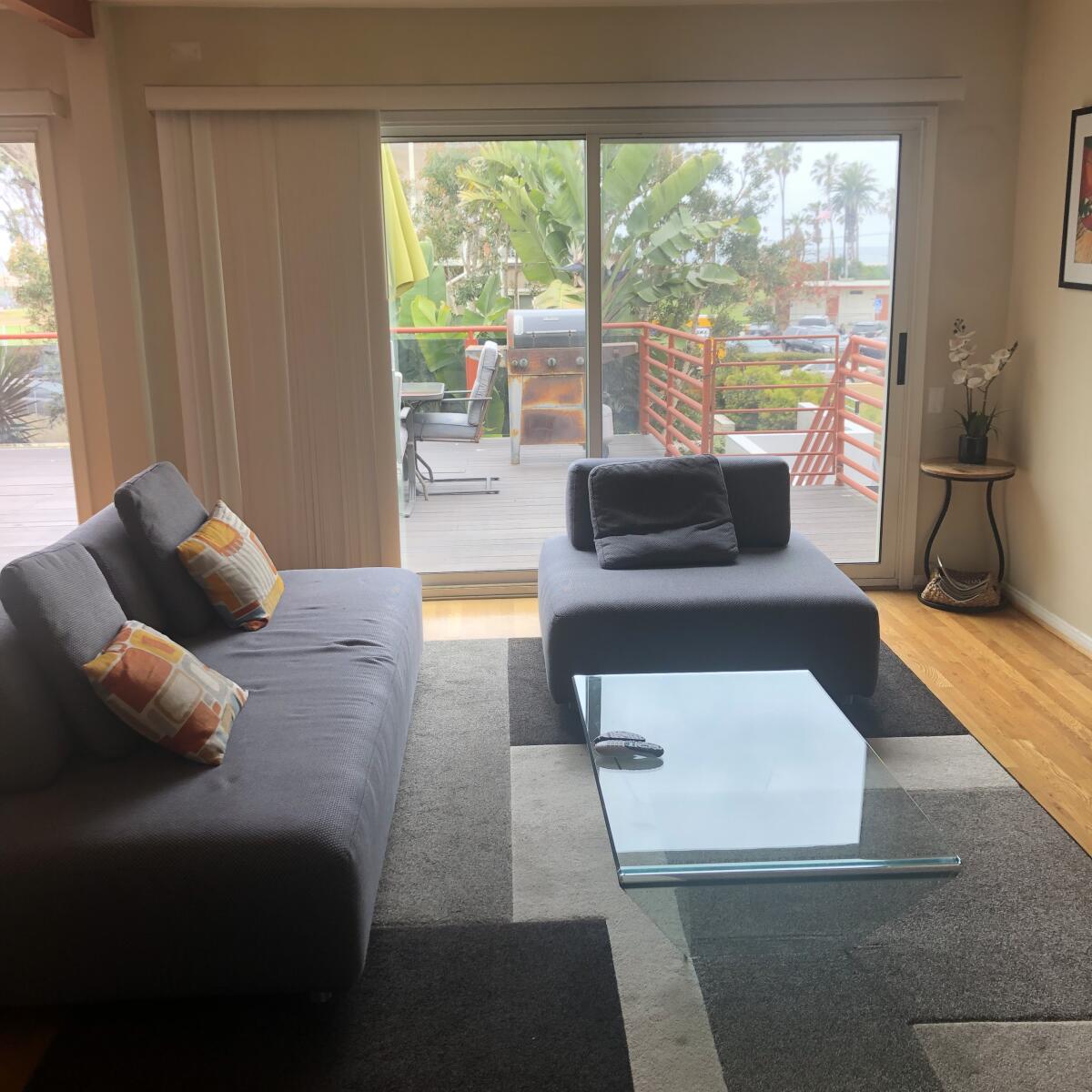
Now, roughly two-thirds into that journey, I’m beginning to think Playa del Rey might be the place. But before I settle in, I decide to unpack. It shouldn’t take long; I moved here with a bare minimum of possessions. Some of this was helped by my somewhat regimented look: I tend to wear shirts in three colors — blue, white or blue-and-white — and pair them with a nearly unending supply of khaki pants. So as I went through my closet back in New York in January, I realized I didn’t have to bring all 24 of the nearly identical shirts I counted. Eight would do. Nor did I need 12 pairs of khakis. Three would have to suffice. I Marie Kondo’d the rest of my wardrobe (two blazers, one suit, three sweaters) so that all of it, plus my laptop, toiletries and a couple of books, fit into a small suitcase and a backpack. Mobility would be key over the next six months.
After watching bicyclists whiz by on the nearby beach path, I head into the bedroom to quickly empty those two bags and get back to the deck. As I do so — hanging up the shirts, shaking out the suit, putting the sweaters into a drawer; a routine I’ve become awfully familiar with over the last five months — something begins to nag at me. Something doesn’t feel quite right. Then it hits me: the first major misstep of my nomadic journey around L.A.
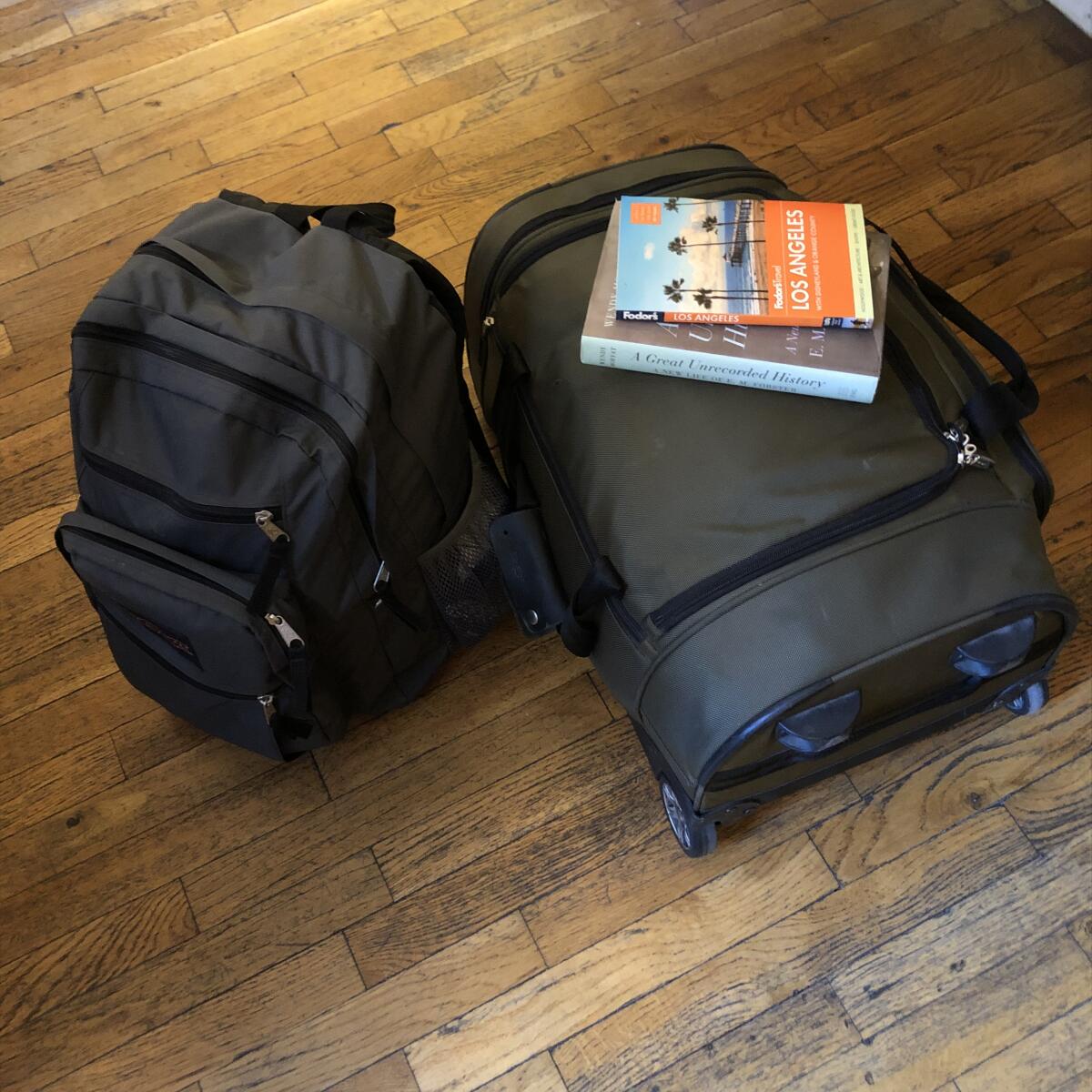
I had inexplicably left all my underwear and socks – freshly laundered and neatly folded – on the bed of the Airbnb I had vacated that morning. (God knows what the cleaning crew thought when they arrived to get the place ready for the next tenant.) I stood there in a moment of panic. Should I go back to the other house and see if the cleaners were still there? Should I try to contact the owner? Or should I just pick up my phone, go to Amazon and order a fresh supply of everything?
Amazon it was. Time for that sunset cocktail.
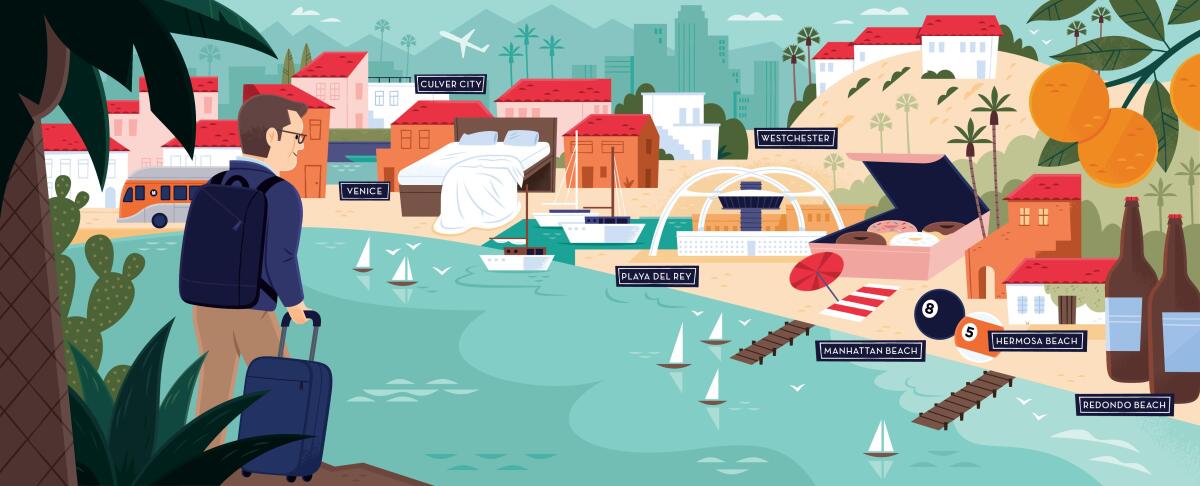
First stop: Westchester
When I arrived in L.A., I came without three things: a permanent residence, a car or a driver’s license. And I was determined to keep it that way for as long as possible.
First, I wanted to see as much of Los Angeles as I could before I settled on a neighborhood, and I figured — given the city’s size and the difficulty of getting from one far-flung spot to another — the best way to get to know a neighborhood was to live there for a few weeks or so. So despite the challenges it might pose, and the potential pitfalls ahead, Airbnb (and occasionally VRBO) would be my go-to housing option until I decided to settle down.
Second, I haven’t had a driver’s license in more than 25 years. I have almost always walked or taken mass transit to work in two cities I have lived in over the last 30 years, New York and London. Walking was probably not going to be a practical option – the L.A. Times, where I now work, is in a non-residential part of El Segundo, right in the shadow of Los Angeles International Airport. So I was going to try to rely on mass transit as much as possible, with Uber and Lyft a backup where needed, even if many of my new colleagues just rolled their eyes when I asked about the bus and Metro system here. (Of course, these were the same colleagues who, when I asked where they lived and how long it took them to get to work, would answer with a variation on the same theme: “Well, if I leave at 7:15, it usually takes me a half hour. But if I leave at 7:30, it can take more than an hour and a half.” No, thank you.)

So I set out with certain parameters. On a map, I drew a circle around El Segundo, estimating what might be within a half-hour commute and seemed to have either a bus line or a train that would bring me within walking distance of the office. The beach towns — Marina del Rey, Manhattan Beach, Hermosa Beach, Redondo Beach, Venice — all seemed to qualify, as did Playa del Rey. Plus, it seemed only right that if I were to come to California, I should try to live near the Pacific Ocean. Inland, I checked off Culver City and Westchester. Downtown El Segundo, a short bus ride from the office, might also be a possibility. Then I spent hours on Google Maps, trying to pinpoint specific neighborhoods in those towns where I could find four essentials — a few restaurants, a supermarket, a liquor store and a dry cleaner — within walking distance. And finally, I scoured the almost completely unintelligible and largely unnavigable LA Metro website trying to decipher the routes and timetables of dozens of bus lines and a handful of train lines. (See accompanying article.)
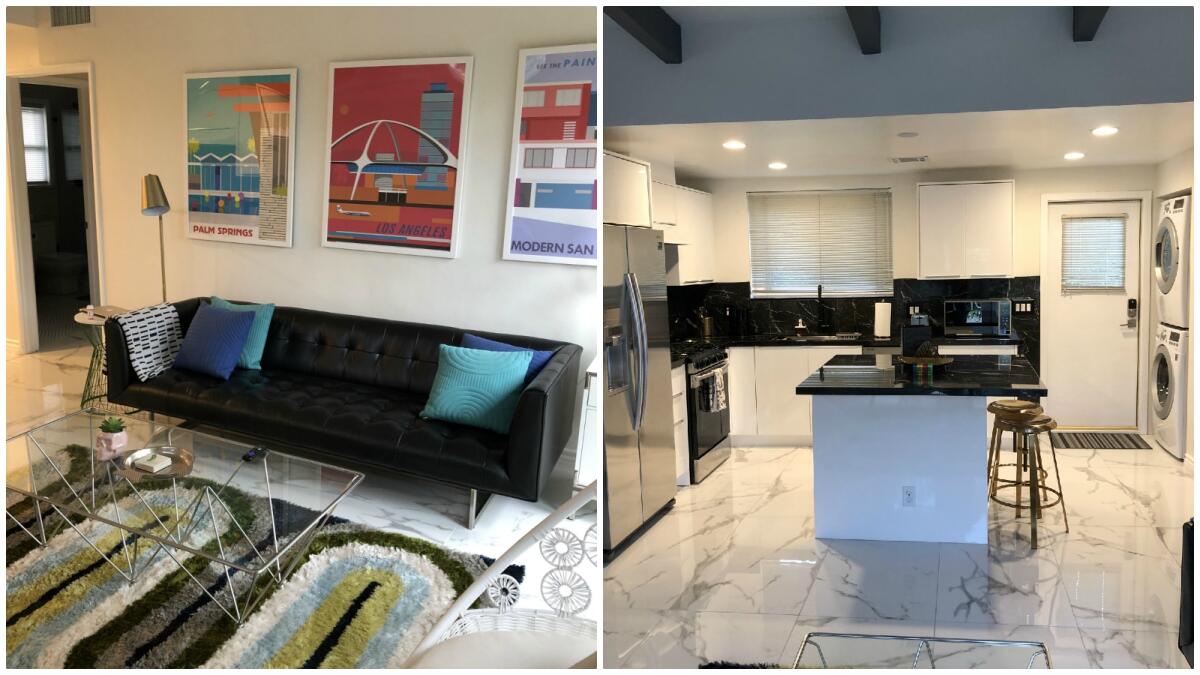
Before getting on a plane to L.A., I booked my first stop, Westchester, in an Airbnb that listed itself as located in “Silicon Beach,” though when I arrived, no beach was in sight, just the nearby runways of LAX, and I never ran into anyone who worked in the tech industry over my two weeks there.
The apartment, an impeccably furnished one-bedroom with a lovely private terrace, and renting for $120 a night, seemed ideal at first. But it took me two days before I finally figured out how to use the TV; the only nearby restaurants were a Denny’s and a curious place that had Italian food on one side of the menu and Lebanese on the other; and the nearest supermarket was a mile-walk away. I could get to work in about 15 minutes by Uber, but going by bus meant a journey of more than 45 minutes, including a transfer. As I announced to a colleague soon after moving in, “One down. I am not moving to Westchester.”
Smoke alarms and Buddhist chimes
“Thump.” I’m lying in bed early on a Tuesday morning in mid-March and I hear a sound coming from the small garden off the bedroom in the tiny Redondo Beach bungalow I moved into the night before (the third stop on my journey; $140 a night). “Thump. Thump.” I get out of bed and open the Dutch door leading out to the garden and there in front of me is an orange tree, pendulous with ripe fruit, three of which have apparently just fallen to the ground. I pick them up, head to the kitchen, turn a small cup into a makeshift juicer. Breakfast!
One of my goals when I moved to L.A. was to try to commute to work by mass transit. Here’s what I learned.
Those were the serendipitous moments that made this moving around from home to home, from neighborhood to neighborhood, seem like it might actually be a good idea. One place might have a great view of the ocean, or be within walking distance to a great wine bar -- Zinqué in Venice, three blocks from the Airbnb I rented in July, was a place where I could have eaten dinner every single night of my stay. Another might be so tiny that the smoke alarm went off every time I tried to fry some bacon for breakfast, but it had that fruit-filled orange tree within arms’ reach. And in Manhattan Beach, my second stop ($205 a night), the lock required an impossibly complicated app to open, but it was also where I had my first experience with Alexa and found myself strangely thrilled when I would get home from work and say, “Alexa, play Joni Mitchell,” and the sound of “You Turn Me On, I’m a Radio” would fill the room.
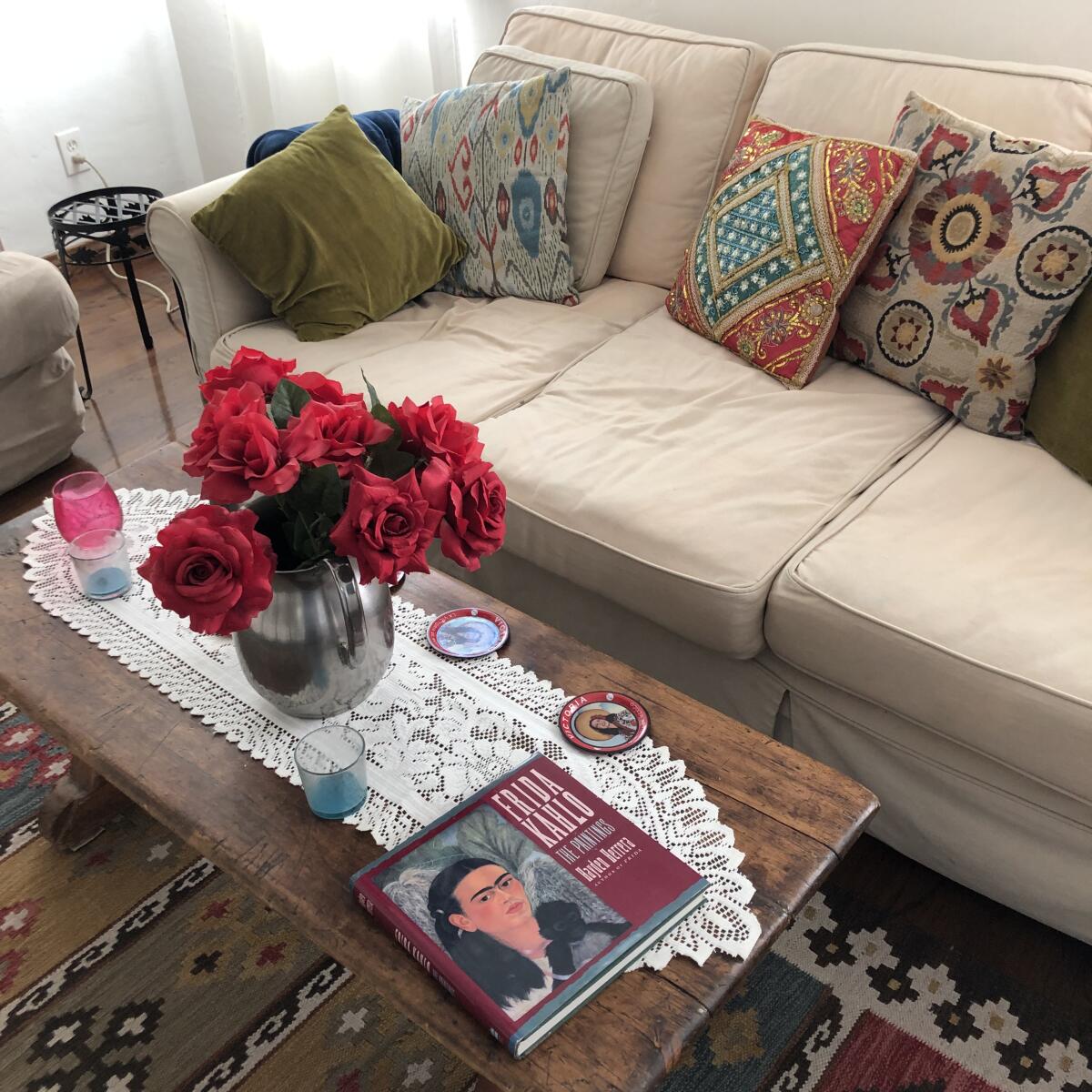
But there is no denying there is something slightly disorienting about continually staying in someone else’s home and living among their possessions, wondering how many people have used these sheets and towels, analyzing their taste in artwork or books — one spot in Manhattan Beach was a near shrine to Frida Kahlo — or preparing to cook dinner one night and realizing the owners may have four kinds of olive oil and six kinds of salt but not a simple colander to drain the pasta you’re about to make. And each place I stayed at seemed to have its own very elaborate TV system — Roku, Apple TV, Sling, you name it — that I would invariably spend my first few hours trying to master, or high-tech washers and dryers or air conditioning systems that I never quite figured out.
And then there are the quirks of the owners themselves. A few were phantom presences. I never heard from them from the moment I checked in to the day I left. Others seemed all too happy to have a guest on the premises. One owner texted me as I headed toward her place in an Uber, saying, “I have a couple of cold beers for you!” and then welcomed me into the bungalow behind her home, showing me how everything worked and suggesting nearby places to shop and eat. Finally, she was gone -- only to return 15 minutes later with a welcoming biscotti. She later texted me that she was about to order some Thai. Did I want some? (No, I lied, I was about to meet a friend for dinner.)
Some people love this kind of attention. In fact, the reviews on the Airbnb site were unanimous raves. But I found it nerve-racking, especially after living in New York, where my apartment building neighbors and I did little more than nod at each other as we passed in the lobby -- and certainly none ever texted me suggesting we share Thai takeout. One day, about a week into my stay, I was walking home from the bus stop, and as I approached the house, I saw her standing in the driveway, about to get in the car. I literally stopped dead in my tracks and shielded myself behind some shrubbery until she had driven away. Childish behavior, I know. But I just couldn’t face yet another conversation or offering of food.
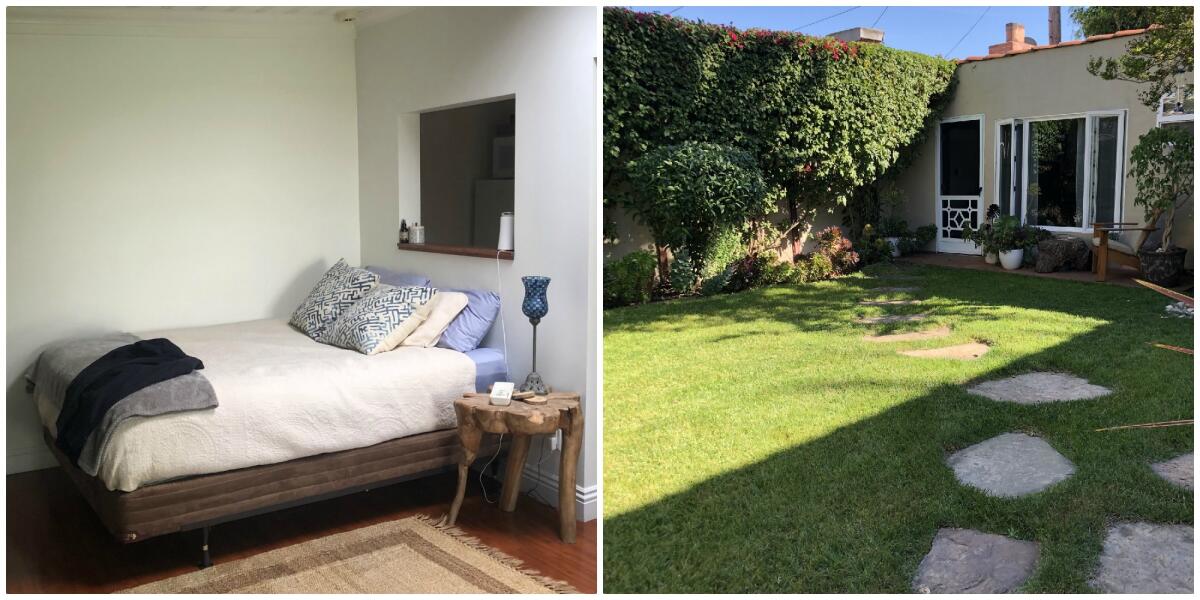
And then there were the owners whose home in Culver City (stop No. 5; $110) was a temple of serenity. The very detailed instructions mentioned respecting the “aura” of the one-room studio, which was filled with 17 candles (soy-based, of course), dishes and cups that had “namaste” and “breathe” and “serenity” imprinted on them, and a stack of books by the bed that included such self-help tomes as “You Only Live Once” and “If Not Now, When?” Outside the bedroom window, Buddhist chimes clanged throughout the night. I never did see the owners, and those books went unopened, but I did my best to stay there without disturbing the aura they had carefully curated.
Fortunately, most of the Airbnbs I have stayed at looked remarkably like the photos on the website – friends had warned that the spaces could look much smaller and not as well-maintained as they appeared in the artfully staged photos -- and a careful vetting of the reviews (anything about the place not being spotlessly clean was an immediate disqualifier) seemed to pay off.
Well, not always. During the end of my journey of serial stays, I walked up to an apartment on a quiet street in El Segundo (stop No. 9; $100). The living room was smaller and darker than I had been led to believe, and the bedroom was even smaller, barely holding the double bed it contained. And the bed itself had not been made; a comforter had just been tossed on top of a fitted sheet. Then I walked into the bathroom and found no clean towels. Instead, a pile of dirty ones filled a nearby hamper.
Then it hit me: The place had not been cleaned since the last guest had left!
I quickly emailed the owner, complaining about the condition of the apartment. When an hour went by and I didn’t hear back, I decided I couldn’t spend the night and found a nearby hotel that I checked into. (Adding $240 to the cost of that first night’s stay.) I also went to the Airbnb site to complain about the apartment not being ready. I got back this reply: “Thank you for your message. Airbnb Support will reply as soon as a specialist becomes available.”
Late that night, I got a text from the owner. He said he was “sorry” and that “your apartment will be ready tomorrow.” Eventually, he offered to reimburse my hotel stay, and a day later Airbnb customer service followed up (via text) to make sure the place had been cleaned and that my hotel stay was being paid for. I was skeptical, but then I got an email about 12 hours later, with a subject line, “Your host sent you money,” confirming that $240 had been refunded to my credit card.
‘I’m going to call the police’
That was my most disappointing experience but not the strangest one. In July, I returned for a few days to one of my favorite homes, a lovely studio off a tiny side street in south Redondo Beach. I had just flown in from London, with a stopover in New York, and I was tired, clammy and slightly disoriented from the time change and lack of sleep.
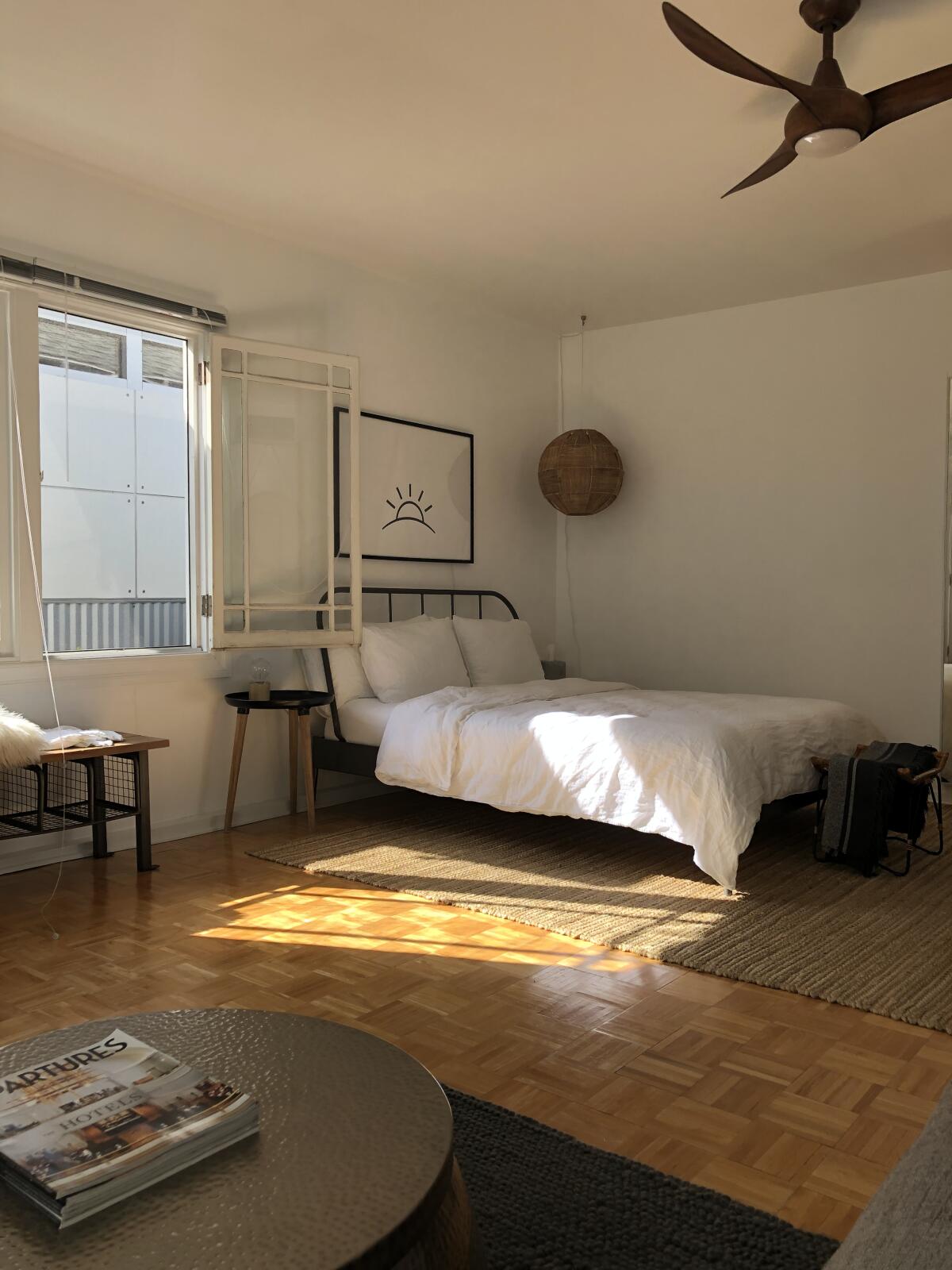
As I entered the studio, I dropped my bags on the floor and headed toward the bathroom for a long, hot shower. A few minutes later, I emerged from the shower, feeling slightly refreshed, and was toweling off as I headed into the adjoining kitchen.
And standing there was a woman – curly-haired and probably in her mid-30s – charging her phone. “Who are you?” I screamed. “What are you doing here?”
“I’m charging my phone,” she said, as if that were the most natural thing in the world.
“Are you crazy? Get out of here,” I once again yelled, “I’m going to call the police. Now.”
“Why would you do that?” she said. “I’m just charging my phone.”
“I’m calling the police,” I said, tightening my towel and looking for my phone.
At that, she bolted out the door – taking her phone but nothing else – and scampered down the street and out of sight.
I texted the owner, who immediately came over (and later called the police to report the incident) and who seemed almost as shaken as I was. She pulled out her phone, and we checked the video that had been sent to it by the security camera installed above the front door. It showed me arriving at the bungalow, dropping my bags off — and leaving the door open behind me! Shortly after, the woman walks by, sees the door is ajar and walks in, phone in hand. The final images are of the woman scuttling down the street and me standing in the doorway, dripping wet and clutching a towel, yelling after her, “Who are you? Who are you?”
This feels very familiar
It’s a Saturday morning in late June, my last day in Playa del Rey before moving on to my next stop. As I walk along the beach, I look up and a plane flies overhead, leaving LAX for parts unknown, followed by another and then another. I’m reminded of my childhood in Long Beach, N.Y., a tiny beach town on the western end of Long Island and right in the flight path of John F. Kennedy airport. As a young child, I looked up, saw those planes taking off and wondered just where they were going. The possibilities seemed tantalizingly endless.
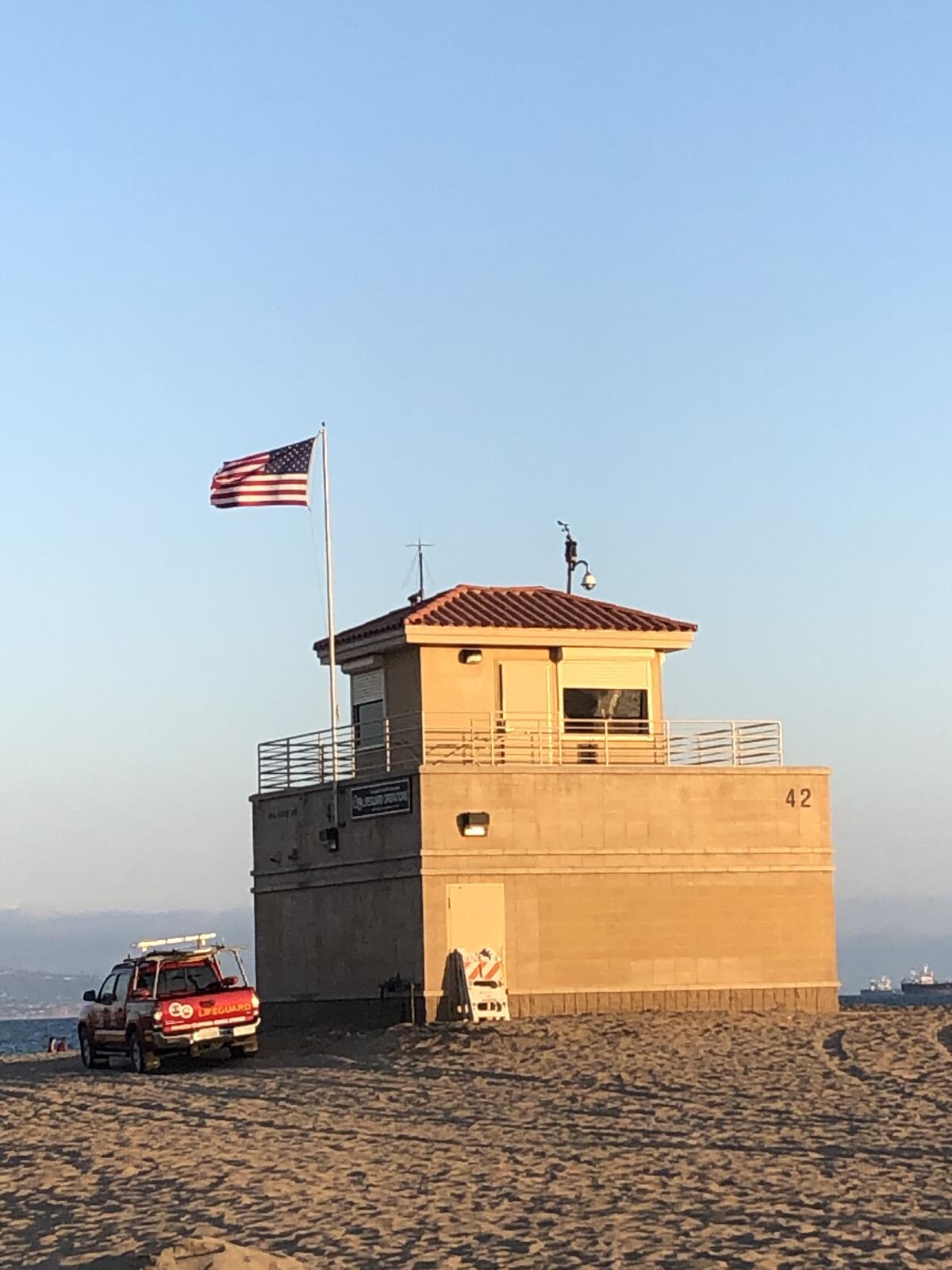
Like the East Coast Long Beach, Playa del Rey is a classic beach town, with aging, modest bungalows nudged up against more modern, more expensive palaces. And trendy restaurants like Playa Provisions share the street with throwback dive bars like the Harbor Room and Mo’s that reminded me of Shines, the ramshackle bar where my father, a former lifeguard, used to hang out with his buddies when he was newly married -- and, later, to which he would take my brother and me (both of us under 10) when it was his weekend to have the kids. (An aside: Last year, I took some friends back to Long Beach, to scatter my father’s ashes by his old lifeguard stand, and we began the day with a stop into Shines for Bloody Marys. As we pulled open the creaky wooden door and stepped into the darkened space – full at 11 on a Saturday morning – I announced, with a touch of gallows humor, “Yes, this is the bar that broke up my parents’ marriage.”)
On that last night, I headed into Mo’s for dinner and grabbed a spot near the pool table. I’d already been here several times during my stay in Playa, and it fast became my regular spot. Mo’s is a shockingly good restaurant disguised as a rundown sports bar and pool hall. The waitresses (straight out of “Alice Doesn’t Live Here Anymore”) call you sweetheart, pat you on the shoulder as they pass and make sure the bartender gives you a generous pour. Four different sports typically play on the TVs suspended above the bar, and some of the patrons look like they haven’t strayed from those spots in weeks.
I usually order a burger, but that night I spotted the special — rack of lamb — on the menu and I skeptically asked Jan, my server, if it was any good. She looked at me sternly, and said, “It will be the best you’ve ever had.” She was right.
Playa del Rey, you’re beginning to feel like home.
More to Read
Sign up for The Wild
We’ll help you find the best places to hike, bike and run, as well as the perfect silent spots for meditation and yoga.
You may occasionally receive promotional content from the Los Angeles Times.
